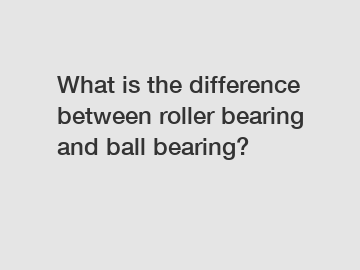What is the difference between roller bearing and ball bearing?
What is the difference between roller bearing and ball bearing?
When it comes to machinery and mechanical systems, bearings play a vital role in ensuring smooth and efficient operation. Bearings are designed to reduce friction between moving parts, allowing them to rotate freely with minimal resistance. Two commonly used types of bearings are roller bearings and ball bearings. While both serve the same purpose, they have distinct differences that make them suitable for various applications. So, let's delve into these differences and understand which type of bearing best suits your needs.
1. Design and Structure:

The fundamental difference between roller bearings and ball bearings lies in their design and structure. Ball bearings utilize balls as the rolling element, housed within an inner and outer ring. These steel or ceramic balls make contact with the raceways, providing a point contact that offers low friction and high radial load capacity. On the other hand, roller bearings replace the balls with cylindrical, tapered, or spherical rollers. These rollers have a larger contact surface area compared to balls, resulting in increased load-carrying capabilities.
2. Load Capacity:
The load-carrying capacity is a crucial factor to consider when selecting the right type of bearing. Roller bearings, due to their larger contact area, can handle higher radial and axial loads. This makes them suitable for heavy-duty applications such as conveyor systems, rolling mills, and gearboxes. On the contrary, ball bearings have a smaller contact area, making them more suitable for lighter loads and high-speed applications like electric motors, fans, and appliances.
3. Friction and Efficiency:
Friction is an essential aspect of bearing performance as it affects energy consumption and heat generation. Ball bearings offer low friction due to the point-contact nature of the steel or ceramic balls, allowing for smooth operation and reduced power loss. In contrast, roller bearings have a line contact, resulting in slightly higher friction. However, advancements in bearing technology have minimized this difference, making both types efficient in their respective applications.
4. Speed and Precision:
The choice between roller bearings and ball bearings also depends on the required rotational speed and precision. Ball bearings are known for their ability to handle high-speed applications due to the reduced friction and low inertia. Their agility makes them suitable for applications like aerospace, automotive engines, and high-performance machinery. Roller bearings, with their larger contact surface, are more robust and better suited for applications that require precise motion control and high accuracy.
In conclusion, the difference between roller bearings and ball bearings lies in their design, load capacity, friction, speed capabilities, and precision. While ball bearings are ideal for high-speed applications, roller bearings excel in heavy-duty and precision-driven machinery. It is important to carefully consider these factors when selecting the appropriate type of bearing for your specific application. Both roller bearings and ball bearings have their unique advantages, so it's crucial to evaluate your needs and consult with a bearing expert if necessary. So, next time you come across the question, "What is the difference between roller bearing and ball bearing?" you'll be equipped with the knowledge to make an informed decision for your machinery.
Want more information on tensioner bearing manufacturer, function of clutch release bearing, what is a cross shaft? Feel free to contact us.


